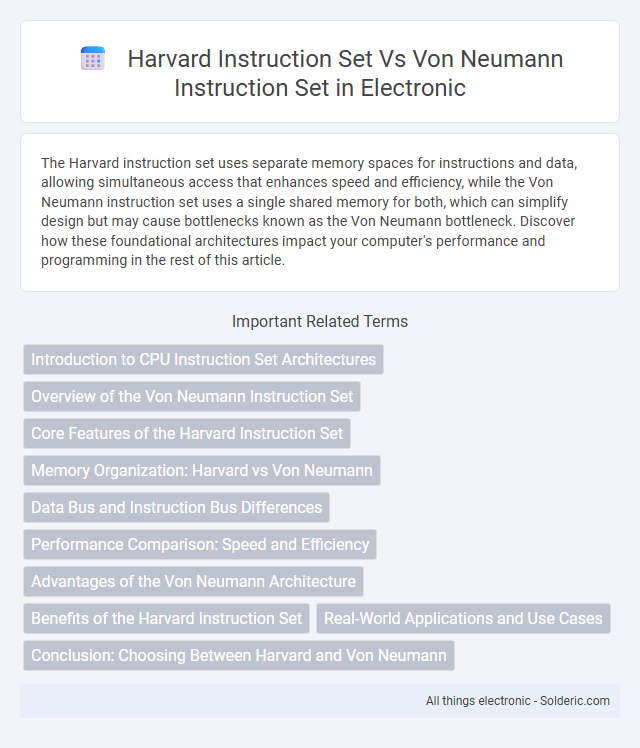The Harvard instruction set uses separate memory spaces for instructions and data, allowing simultaneous access that enhances speed and efficiency, while the Von Neumann instruction set uses a single shared memory for both, which can simplify design but may cause bottlenecks known as the Von Neumann bottleneck. Discover how these foundational architectures impact your computer's performance and programming in the rest of this article.
Comparison Table
| Aspect | Harvard Instruction Set | Von Neumann Instruction Set |
|---|---|---|
| Architecture | Separate memory for instructions and data | Shared memory for instructions and data |
| Memory Access | Simultaneous access to instructions and data | Single access path for instructions and data |
| Performance | Higher throughput, reduced bottlenecks | Lower throughput due to shared bus |
| Complexity | More complex hardware design | Simpler hardware architecture |
| Memory Usage | Separate memories may increase resource needs | Efficient memory usage with unified memory |
| Instruction Fetch | Faster instruction fetch via dedicated path | Instruction fetch competes with data access |
| Common Applications | Embedded systems, DSPs where speed is critical | General-purpose computers, most CPUs |
Introduction to CPU Instruction Set Architectures
The Harvard instruction set architecture separates the memory spaces for instructions and data, enabling simultaneous access and faster processing speeds in CPUs. In contrast, the Von Neumann instruction set architecture uses a single memory space for both instructions and data, simplifying design but potentially causing bottlenecks due to sequential access. These fundamental differences influence CPU efficiency, memory management, and performance in various computing applications.
Overview of the Von Neumann Instruction Set
The Von Neumann instruction set utilizes a single memory space to store both instructions and data, leading to a unified architecture that facilitates sequential instruction processing. It relies on the Von Neumann bottleneck, where the CPU fetches instructions and data through a shared bus, potentially causing delays. Your understanding of this set highlights its simplicity and common use in general-purpose computers, contrasted with the Harvard architecture's separate memory for instructions and data.
Core Features of the Harvard Instruction Set
The Harvard instruction set architecture features separate memory spaces and buses for instructions and data, enabling simultaneous access and increased processing speed. It supports parallelism by allowing instruction fetch and data operations to occur concurrently, reducing bottlenecks typical in Von Neumann architectures. This separation enhances efficiency in embedded systems and digital signal processing applications where fast, predictable performance is critical.
Memory Organization: Harvard vs Von Neumann
Harvard architecture features separate memory spaces for instructions and data, allowing simultaneous access that enhances processing speed and efficiency. Von Neumann architecture uses a single memory space for both instructions and data, which can lead to bottlenecks known as the Von Neumann bottleneck due to sequential access. The distinct memory organization fundamentally affects system throughput and complexity in both architectures.
Data Bus and Instruction Bus Differences
The Harvard instruction set architecture features separate data bus and instruction bus pathways allowing simultaneous access to instructions and data, enhancing processing speed and efficiency. In contrast, the Von Neumann instruction set uses a single shared bus for both data and instructions, causing potential bottlenecks as fetching and execution cannot occur in parallel. Your system's overall performance can significantly improve by adopting Harvard architecture due to its dual-bus design optimizing data throughput.
Performance Comparison: Speed and Efficiency
The Harvard instruction set offers higher speed and efficiency by using separate memory spaces for instructions and data, enabling simultaneous access and reducing bottlenecks in processing. In contrast, the Von Neumann instruction set shares the same memory for instructions and data, often causing delays due to sequential fetching. You benefit from the Harvard architecture's faster instruction throughput, making it ideal for applications requiring high performance and real-time processing.
Advantages of the Von Neumann Architecture
The Von Neumann architecture offers a simplified design by using a single memory space to store both instructions and data, reducing hardware complexity and cost. This unified memory model enables easier implementation of self-modifying code and dynamic program execution, enhancing flexibility. Your system benefits from efficient instruction sequencing and streamlined control flow, which supports faster development and debugging processes compared to the Harvard architecture.
Benefits of the Harvard Instruction Set
The Harvard instruction set architecture benefits from separate memory spaces for instructions and data, enabling simultaneous access that increases processing speed and efficiency. This separation reduces bottlenecks commonly found in Von Neumann architectures, where both instructions and data share the same memory path. You can achieve faster execution times and improved performance in embedded systems and digital signal processing with Harvard architecture.
Real-World Applications and Use Cases
Harvard instruction set architecture excels in real-time embedded systems and digital signal processing due to its separate memory pathways for instructions and data, allowing faster and more efficient execution. Von Neumann instruction set architecture remains dominant in general-purpose computing environments like personal computers and servers, benefiting from its unified memory model that simplifies program design and flexibility. The use cases for Harvard architecture include microcontrollers in automotive and aerospace industries, while Von Neumann architecture is widely employed in desktop applications, operating systems, and web servers.
Conclusion: Choosing Between Harvard and Von Neumann
The choice between Harvard and Von Neumann instruction sets depends on specific application requirements such as speed, complexity, and cost efficiency. Harvard architecture excels in scenarios demanding high-speed data processing and parallelism due to separate memory pathways, while Von Neumann architecture offers simplicity and lower costs with a unified memory system. Designers prioritize Harvard for real-time embedded systems and signal processing, whereas Von Neumann remains preferred for general-purpose computing and ease of programming.
Harvard instruction set vs Von Neumann instruction set Infographic

 solderic.com
solderic.com